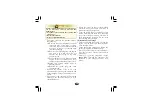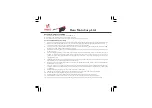
69
CATALYTIC CONVERTER
This vehicle is equipped with a catalytic
converter in the muffler.
The catalytic converter contains noble metals
that serve as catalyst, promoting chemical
reactions to convert CO and HC in the
exhaust to CO and H O (water vapour).
2
2
•
Keep the engine tuned up.
Follow these guidelines to protect your
vehicle’s catalytic converter.
A defective catalytic converter contributes to
air pollution and can impair your engine’s
performance.
•
Always use unleaded petrol. Even a small
amount of leaded petrol can contaminate
the catalyst metals, making the catalytic
converter ineffective.
Polishing or waxing is not applicable for
models having matte paint.
NOTE
POLISHING OF VEHICLE
After washing your vehicle, wax all painted
surfaces (except matte painted surfaces) using
a commercially available polish/quality liquid
or paste wax to finish the job. Use only a non
abrasive polish or wax made specifically for
automobiles. Apply the polish or wax
according to the instructions on the container.
•
Change the engine oil.
The road may contain salt which was sprayed
as an anti freezing agent during winter, and
the seawater are the causes of rust.
these repairs may be forgotten by the time the
vehicle is removed from storage.
REMOVING ROAD SALT
Wash your vehicle when run on such
conditions by the following the point
mentioned below, Clean the vehicle using cold
water
(page 51)
. Do not use warm water.
This worsens the effect of the salt.
STORAGE GUIDE
Extended storage, such as for winter, requires
that you take certain steps to reduce the
effects of deterioration from non use of the
vehicle. In addition, necessary repairs should
be made before storing the vehicle, otherwise
(a) Storage
•
Empty the fuel tank into an approved petrol
container using a commercially available
hand siphon or an equivalent method.
•
Spray the inside of the tank with an aerosol
rust inhibiting oil.
•
Reinstall the fuel filler cap on the tank.













































